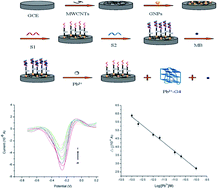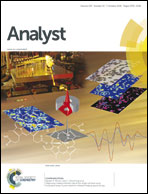Highly sensitive electrochemical sensor using a MWCNTs/GNPs-modified electrode for lead (II) detection based on Pb2+-induced G-rich DNA conformation
Abstract
A sensitive electrochemical lead ion (Pb2+) sensor based on carboxylic acid group functionalized multi-walled carbon nanotubes (MWNTs-COOH) and direct electrodeposited gold nanoparticles (GNPs) was developed for Pb2+ detection. The DNA capture probe was self-assembled onto the surface of the modified electrode for hybridizing with the guanine-rich (G-rich) aptamer probe and for forming the DNA double helix structure. When Pb2+ was added in, the DNA duplex unwound and formed a stabilized G-quadruplex (G4) due to the Pb2+-induced G-rich DNA conformation. Also, methylene blue (MB) was selected as the G4-binding indicator. Compared with previous Pb2+ sensors, the proposed sensor had better sensitivity, because the modified MWCNTs/GNPs could provide a large surface area and good charge-transport capacity to dramatically improve the DNA attachment quantity and sensor performance. The sensor could detect Pb2+ in a range from 5.0 × 10−11 to 1.0 × 10−14 M, with a detection of 4.3 × 10−15 M.


 Please wait while we load your content...
Please wait while we load your content...